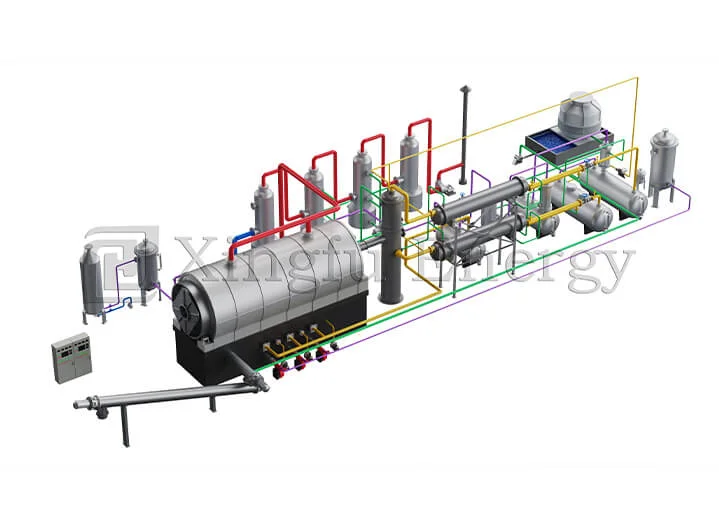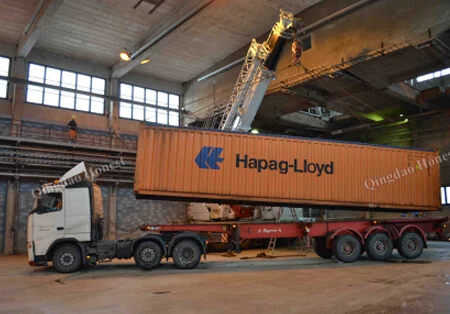A pyrolysis reactor is a unique device built to break down organic materials through heat in an oxygen-free environment. This method, called pyrolysis, converts waste items like plastics and tires into useful products such as fuel oil, carbon black, and syngas. The reactor functions at high, controlled temperatures. It transforms complex molecular structures into simpler substances.
These reactors are commonly utilized in industries focused on recycling waste and cutting down environmental harm. They are essential for sustainable waste handling and energy retrieval.

A pyrolysis system includes several vital parts that collaborate for smooth operation. These are:
Feeding System: This part delivers raw materials, such as tires or plastics, into the reactor. Some setups allow whole tire feeding without shredding. This cuts preparation time and expenses.
Reactor: The main section where heat decomposition happens under high temperatures and no oxygen.
Cooling System: A multi-level cooling setup is often used. It boosts fuel oil collection. Adopt multilevel cooling circulation to get more fuel oil.
Condensation Unit: Turns gaseous byproducts into fuel gas for heating purpose
Dust Removal System: Keeps emissions low during the process. Pulse dust removal during discharge process, no dust emissions.
Discharge Mechanism: Manages the removal of solid leftovers, such as carbon black and steel wire, after pyrolysis.
Control System: Automates tasks for better efficiency and safety.
Pyrolysis systems serve various purposes in industry:
Waste Management: They turn waste tires and plastics into reusable goods.
Energy Production: They create fuel oil and syngas for power needs. The fuel oil can be used to diesel motor (high power, low rotating rate), heating furnace, metallurgical and industrial furnace.
Material Recovery: They produce carbon black for rubber production.
Environmental Protection: They lessen reliance on landfills and reduce pollution.
Continuous pyrolysis systems run without stopping. They enable a steady flow of input and output. These setups are designed for large-scale tasks. They suit industries needing high output.
Their main traits include:
Fully automated feeding setups.
Steady material movement through the reactor.
Efficient heat reuse designs. Hot air heating, unique heat recycling design, to reduce the operating cost.
Reduced downtime thanks to smooth workflows.
Continuous systems stand out for their energy-saving features:
Syn gasproduced during pyrolysis is reused in the system for heating
Advanced insulation cuts down on heat loss.
Automated controls fine-tune energy use across steps.
These aspects lead to lower running costs and less environmental harm compared to older methods.
Advantages:
High capacity fits industrial-scale needs.
Less labor needed due to automation. Easy operation, high efficiency, 1-2workers to operate.
Steady conditions ensure consistent product quality.
Limitations:
Higher upfront costs due to advanced tech.
Maintenance can be complex and needs skilled workers.
Batch pyrolysis systems handle materials in separate loads rather than continuous type. Workers load a set amount of material into the reactor. It undergoes pyrolysis. Then, it’s cleared out for the next load.
These systems are simpler than continuous ones. They are often chosen for smaller operations or places with tight budgets.
Batch reactors often use more energy per unit processed. This is due to repeated heating rounds:
Each load needs preheating to reach the right temperature.
Cooling breaks between loads can waste energy.
Still, newer designs try to lessen these drawbacks. They use better insulation and heat-holding tech.
Strengths:
Lower initial cost compared to continuous setups.
More flexibility for handling different materials or smaller amounts.
Easier to run with less need for automation.
Weaknesses:
Higher energy use per unit processed.
Slower output, unfit for big demands.
More labor needed due to manual steps between loads.
Energy efficiency in pyrolysis systems depends on various elements. These include reactor design, heat control methods, and operational habits. Continuous systems are built to reduce energy waste. They use advanced insulation and heat reuse techniques. Hot air heating, unique heat recycling design, to reduce the operating cost. They run without breaks, ensuring steady energy use.
Batch systems struggle with efficiency. This is because of repeated heating and cooling phases. Each load needs warming up to hit pyrolysis temperatures. This raises energy use. However, modern batch reactors use better insulation and heat retention to lessen these losses.
The feedstock type also matters. Materials with higher energy content can add power during pyrolysis. This boosts overall efficiency. Plus, the operation’s size affects energy use. Bigger systems often gain from scale benefits.
Good heat control is key to improving pyrolysis reactor performance. Continuous systems do well here. They reuse heat made during the process. Smart designs redirect extra heat back into the system. This cuts fuel needs and running costs.
Batch systems have limits in heat regulation. They work in separate cycles. Repeated heating raises energy use. Yet, new features like airtight high-temperature feeds help. They save heating time and reduce temperature loss. Airtight high temperature feed, saving heating time and reduce temperature loss.
Both system types use multi-level cooling setups. This increases fuel oil recovery. Adopt multilevel cooling circulation to get more fuel oil. It improves energy efficiency. It also enhances byproduct quality, like pyrolysis oil.
Continuous systems are often kinder to the environment. They use energy well and cut emissions. Features like pulse dust removal keep impacts low. Pulse dust removal during discharge process, no dust emissions. They also make steady byproducts for reuse.
Batch systems may leave a bigger environmental mark. This is due to higher fuel use and possible emissions from multiple heating rounds. Still, design upgrades have led to cleaner runs. They reduce dust and pollutants. No dust, clean and environmental friendly.
Both systems help by turning waste into useful items. These include fuel oil, carbon black, and steel wire. The fuel oil can be used. Producing carbon black. They also cut landfill reliance.
Choosing between continuous and batch systems hinges on feedstock type and capacity needs. Continuous systems suit large-scale tasks with uniform materials, like whole tires or industrial plastics. Whole tyre feed, no need to cut; reduced the cost. Their automated feeding handles big volumes well.
Batch systems offer flexibility for smaller tasks or varied feedstocks. They work for mixed plastics or smaller waste amounts needing manual sorting.
Knowing the feedstock’s traits is vital for picking the right system. For example, high-moisture materials may need extra drying in batch setups.
Running costs heavily influence system choice. Continuous systems have higher startup costs. But they save money long-term due to energy-saving designs. Easy operation, high efficiency. Automated controls cut labor needs too. 2-3 workers to operate.
Batch systems cost less upfront. Yet, they may have higher running expenses. This comes from more energy use per cycle. Manual steps between loads add labor costs too.
Energy use differs greatly between the two. Continuous reactors gain from nonstop runs with no downtime. Unique heat recycling design. Batch reactors lose efficiency from repeated heating.
Batch systems shine in flexibility. Their simple design lets operators handle varied materials without big changes. This fits facilities with diverse waste or smaller amounts.
Continuous systems lead in scalability. They’re great for industries needing high output. Their automated features allow easy growth without major setup changes. Fully automatic waste tyre pyrolysis plant.
Both systems have unique perks based on goals and resources.

Efficiency relies on reactor design, heat control methods, and feedstock traits. Unique heat recycling design.
Continuous ones run nonstop with automated feeding. Easy operation. Batch ones process set loads with manual steps.
Continuous systems excel here. They offer high capacity, energy-saving designs, and automation. Fully automatic waste tyre pyrolysis plant. Unique heat recycling design.
It cuts landfill use by making products like fuel oil, carbon black, and steel wire. The fuel oil can be used. It also lowers emissions. No dust emissions.
Qingdao Xingfu Energy Equipment Co., Ltd., provides tailored solutions. They specialize in industrial boilers, pressure vessels, and waste tires & plastics pyrolysis system customization services. Located in Qingdao city since 2010.